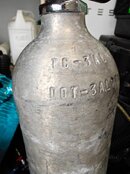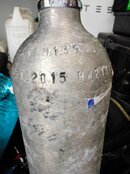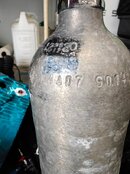All of my Luxfer 14cf 2015 tanks were manufactured in 2007, many years after they stopped using the dodgy aluminum alloy. There is nothing unsafe about the tanks.
You are using an out of date browser. It may not display this or other websites correctly.
You should upgrade or use an alternative browser.
You should upgrade or use an alternative browser.
Luxfer 14cuft 2015 psi Cylinder - hard to find - new hydro $125 shipped
- Thread starter Scared Silly
- Start date
Please register or login
Welcome to ScubaBoard, the world's largest scuba diving community. Registration is not required to read the forums, but we encourage you to join. Joining has its benefits and enables you to participate in the discussions.
Benefits of registering include
- Ability to post and comment on topics and discussions.
- A Free photo gallery to share your dive photos with the world.
- You can make this box go away
All of my Luxfer 14cf 2015 tanks were manufactured in 2007, many years after they stopped using the dodgy aluminum alloy. There is nothing unsafe about the tanks.
Excuse my brain fart on the date above.
Does this mean we have a winner?
@davehicks can you by any chance provide pics all of the factory neck stampings and measurements for confirmation?
@everybody can you cross check my reasoning?
If they were made continuously until at least 2007, then they were current models as of 2003 when the list of changeover dates was published.
See: Sustained-load cracking (SLC) in ruptured scuba cylinder made from 6351 aluminum alloy - Luxfer Gas Cylinders
Sustained-load cracking (SLC) in ruptured scuba cylinder made from 6351 aluminum alloy
SLC is a thoroughly researched and well-documented metallurgical phenomenon that occasionally develops in cylinders made from 6351 alloy, as well as in other types of pressure vessels and structural components under stress for sustained periods of time. SLC has occurred in cylinders manufactured by various companies, including Luxfer. Cylinders that have been mechanically damaged, over-filled or otherwise abused are more susceptible to SLC, which is not a manufacturing defect, but a phenomenon inherent in the metal itself.
Research has consistently shown that sustained-load cracks grow very slowly, typically taking eight or more years to grow large enough to cause a cylinder leak or, in extremely rare cases, a rupture. Because SLC growth is so slow, properly trained inspectors have adequate opportunity to detect cracks and remove cylinders from service during normal annual inspections or as part of the DOT-required requalification process every five years. Both Luxfer and DOT have long maintained that proper, diligent inspection by correctly trained personnel is the best way to avoid cylinder-related accidents.
It is important to note that SLC has occurred only in a small number of older cylinders made from 6351 aluminum alloy. Cylinders made from 6061 aluminum alloy, the metal currently used by all U.S. manufacturers, have not exhibited SLC.
Luxfer discontinued use of 6351 alloy in June 1988 and since that time has only manufactured scuba cylinders from Luxfer’s proprietary L6X® formula for 6061 aluminum alloy. Out of more than 40 million cylinders, no Luxfer cylinder made from L6X® (6061) alloy has ever exhibited a sustained-load crack.
For more detailed information about SLC, visit the Luxfer website at www.luxfercylinders.com, click “Support” on the top menu bar, click “Frequently Asked Questions” on the left-hand menu and then click the “Sustained-load Cracking (SLC)” heading. For specific dates when Luxfer switched different cylinder models from 6351 to 6061 alloy, click “Support,” then “Technical Bulletins” and scroll down to Dates when Luxfer changed its aluminum alloy from 6351 to 6061 (posted November 12, 2003).
If you have additional questions, call Luxfer’s toll-free customer service line: 800-764-0366.
1See Department of Transportation: HM-220F, Federal Register, Vol. 71, No. 167, pages 51122-51129.
Posted by Luxfer
Then according to the date document, since it was a current model in production and not listed on the changeover list it implies that it was ALWAYS 6061. STRONG CAVEAT - It may also simply be an omission on the list!
See: Dates when Luxfer changed its aluminum alloy from 6351 to 6061 - Luxfer Gas Cylinders
Dates when Luxfer changed its aluminum alloy from 6351 to 6061
Between 1987 and 1988, Luxfer Gas Cylinders discontinued use of 6351 aluminum alloy and began using a proprietary version of 6061 aluminum alloy for all its aluminum cylinder models manufactured in the United States. Listed below are the dates by model number when the transitions to the new alloy occurred. Any current Luxfer models that do not appear on this list were never made from 6351 alloy in the first place and have always been made from Luxfer’s proprietary 6061 alloy.
SCUBA
S30, S63 -May 1988
S40 – June 1988
S50, S92 – April 1988
S72, S100 – August 1987
S80 – January 1988
S808 – May1987
SCBA
L7, L8, L13 – September 1987
L13 – May 1988
L15 – January 1989
L26 – February 1988
L45 – November 1987
CO2
C1.2, C1.5 – January 1989
C2 – November 1988
C10 – August 1988
C5 – June 1988
C15 – November 1987
C20, C35 – April 1988
C50 – February 1988
Medical
M9 – January 1988
MD15, ME24 – December 1987
Industrial Gas
N22, N150 – May 1988
N33 – November 1988
N60, N122 – December 1987
N88 – December 1988
Posted by Luxfer
Technical bulletins
FWIW. I still have not heard back from my latest go-rounds with Luxfer after the sent me the changeover-list and I replied that it made no mention of the S14.
I personally would not fill oxygen to 3000 psi and many/most dive operations will not fill O2 past 2400. And very few have a booster. So, filling a 19cf with O2 is generally not possible.It is very clear to most everybody.
a 13 and a 14 aren't even similar. One is a 2L bottle and the other is a 3L bottle.
An AL19 and a 14 are almost the same size. Less than an inch difference between the 2. They are both 3L bottles.
Yes, weight is different. For most people that doesn't matter, for some it does. There aren't many divers flying with tanks.
Volume is the same, if you are only filling them to 2000, you have the same amount of gas. If you won't ever fill them above that, there would be no reason to use a 19 over your 14.
If you travel to places that can fill them up, you could have more gas with the 19 while taking up the same footprint.
It makes some sense to fly with the 14cf O2 bottles because most of the time a rental O2 bottle is a Steel 2L or 3L which I don't prefer. The 2L are too small and the 3L are heavy and long. Mounted horizontally on my Kiss Sprits they protrude a bit.
My understanding is the "04A07" is the date of manufacture, April 2007.Excuse my brain fart on the date above.
Does this mean we have a winner?
@davehicks can you by any chance provide pics all of the factory neck stampings and measurements for confirmation?
@everybody can you cross check my reasoning?
If they were made continuously until at least 2007, then they were current models as of 2003 when the list of changeover dates was published.
See: Sustained-load cracking (SLC) in ruptured scuba cylinder made from 6351 aluminum alloy - Luxfer Gas Cylinders
Then according to the date document, since it was a current model in production and not listed on the changeover list it implies that it was ALWAYS 6061. STRONG CAVEAT - It may also simply be an omission on the list!
See: Dates when Luxfer changed its aluminum alloy from 6351 to 6061 - Luxfer Gas Cylinders
FWIW. I still have not heard back from my latest go-rounds with Luxfer after the sent me the changeover-list and I replied that it made no mention of the S14.
Photos:





Correct 04-2007. Thanks for the pics!My understanding is the "04A07" is the date of manufacture, April 2007.
Photos:
View attachment 890600View attachment 890601View attachment 890602View attachment 890603View attachment 890604
Mine has a snazzy carrier thing to attach it to a regular tank. It's a lot smaller than a 19. (07A93)


Scared Silly
Contributor
The report is for an O2 bottle that suffered mechanical damage not SLC. The O2 bottles are a different production made to a different size than these bottles.Attached is a report of an analysis/evaluation that the DOT contracted back in 1997 after failure of a Luxfer 3AL2015 cylinder.
The report confirms the speculation, in this discussion thread, that these cylinders were made from 6351 alloy and that the 3AL2015 cylinders were (are), at least sometimes, used with O2.
These are the O2 bottles Luxfer was made that were known to use Al6351 before these dates:
Medical
M9 – January 1988MD15, ME24 – December 1987
I believe the bottle in the report is a MD15 which while having the same diameter is different height and thread diameter than S14.
If one looks at the dates, Luxfer started shifting the current production of other cylinders starting in August 1987 not finishing until May 1988. So one cannot use the date as the basis for the material. Let alone cylinder similarities. Thus I disagree with your conclusion.
That is not say this cylinder is not AL6351 (which I have not said) but that one cannot draw a direct conclusion as you have. Especially in light of the following:
Between 1987 and 1988, Luxfer Gas Cylinders discontinued use of 6351 aluminum alloy and began using a proprietary version of 6061 aluminum alloy for all its aluminum cylinder models manufactured in the United States. Listed below are the dates by model number when the transitions to the new alloy occurred. Any current Luxfer models that do not appear on this list were never made from 6351 alloy in the first place and have always been made from Luxfer’s proprietary 6061 alloy.
What we do not know is when these bottles went into production. Let alone when did Luxfer starting using Al6061 for them. So far the earliest production so far seems to be from May 1982 via the report @-JD- linked. Which is also the first report of SLC I have seen in these cylinders. The latest production so far is April 2007 via @davehicks.
But at the same time @-JD- has done a great job at parsing the notice verbiage which one could conclude these cylindering were never made from AL6351.
If they were made continuously until at least 2007, then they were current models as of 2003 when the list of changeover dates was published.
See: Sustained-load cracking (SLC) in ruptured scuba cylinder made from 6351 aluminum alloy - Luxfer Gas Cylinders
Then according to the date document, since it was a current model in production and not listed on the changeover list it implies that it was ALWAYS 6061. STRONG CAVEAT - It may also simply be an omission on the list!
See: Dates when Luxfer changed its aluminum alloy from 6351 to 6061 - Luxfer Gas Cylinders
But then again, I agree with @-JD- that it might be an omission. However, the Luxfer notice is consistent with the DOT advisory issued nearly 10 years early. That is the S14 was never on either list.
Until we hear from Luxfer about the only conclusion I can make is that the information is inconsistent. I have not heard from my contact. It might be a while given Luxfer is going to be digging into the their archives.
Finally, I listed what I knew so the buyer would have full knowledge of what I knew at the time. Which more than most do. As such, I take umbrage at your (@Zef) insinuation.
Very few dive operations have a booster? Seriously? Where are you diving? That seems incredibly odd to me.I personally would not fill oxygen to 3000 psi and many/most dive operations will not fill O2 past 2400. And very few have a booster. So, filling a 19cf with O2 is generally not possible.
It makes some sense to fly with the 14cf O2 bottles because most of the time a rental O2 bottle is a Steel 2L or 3L which I don't prefer. The 2L are too small and the 3L are heavy and long. Mounted horizontally on my Kiss Sprits they protrude a bit.
I probably have at least 30 of them sitting here at my house at this moment. I never would have guessed a dive operator wouldn't have one in 2025.
Very few dive operations have a booster? Seriously? Where are you diving? That seems incredibly odd to me.
I probably have at least 30 of them sitting here at my house at this moment. I never would have guessed a dive operator wouldn't have one in 2025.
You have 30 boosters? I just have two. Want to buy my old one? You seem to be a collector.
I have yet to see one in around a half a dozen dive boats and resorts that cater to CCR divers on the regular. No doubt some remote dive operators have a booster but I've not visited them yet.
Similar threads
- Replies
- 0
- Views
- 826
- Replies
- 0
- Views
- 1,904
- Replies
- 8
- Views
- 871
- Replies
- 16
- Views
- 5,731
- Replies
- 1
- Views
- 366



